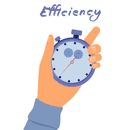Planning Poker vs. T-Shirt Sizing vs. Dot Voting – Key Differences
Discover the key differences between popular agile estimation techniques: Planning Poker, T-Shirt Sizing, and Dot Voting, and pick the best one for your team.

As Agile methodologies have become more dominant in software development, so have the various estimation techniques to estimate the size and complexity of product backlog. Planning Poker, T-Shirt Sizing, and Dot Voting are the three widely used estimation techniques that Agile teams use to estimate the efforts required in their development projects. Each method has its unique approach, benefits, and drawbacks. Therefore, understanding the key differences between them is essential for choosing the right estimation technique for your projects. Therefore, this article discusses in detail the key differences between Planning Poker, T-Shirt Sizing, and Dot Voting estimation techniques. So, let's get started!
Planning Poker
Planning Poker is a relative, consensus-based estimation technique in which the Agile or Scrum team estimates the efforts required for the backlog items (or user stories) by assigning story points. The team uses numbered poker-styled cards, where the sequence of the numbers is based on the Modified Fibonacci sequence, i.e., 0, 1, 2, 3, 5, 8, 13, 20, 40, and 100. The process involves discussing the user stories collaboratively and then providing individual estimates all at once. Afterward, the team finalizes the team's estimate by consensus.
How it Works
- The team gathers to discuss and estimate product backlog.
- Each development team member is given a set of poker cards, with each card containing a number of the Modified Fibonacci sequence to represent a story point.
- The Product Owner narrates the first user story to the meeting participants.
- After listening to the user story, the development team starts the discussion around different points, such as development strategy, potential risks, challenges, etc.
- After discussion, every member secretly picks a poker card, representing their estimate of the effort (story point) required to complete the task.
- All members show their cards simultaneously.
- If there are some major variations, then the team does a discussion again and re-estimates. Eventually, the team reaches a consensus and finalizes the team estimate for that user story.
- The above steps continue until the team completes the estimate of all user stories.
Benefits and Drawbacks
Planning Poker offers several benefits, as follows:
- Accurate Estimates: It involves open discussion and participation of all key development team members, resulting in more accurate estimates.
- Numeric-Scale: It uses the Modified Fibonacci sequence to assign story points to user stories. The numeric scale helps have a better understanding of the required efforts.
- Collaboration: It encourages collaboration, which is helpful for team building.
- Transparency and Fairness: It makes the estimation process transparent and involves everyone's opinion.
- Easy-to-Use: It is an easy-to-use estimation technique that requires no technical skills.
Planning Poker also has some drawbacks, as follows:
- Time-Consuming: As it involves discussing and estimating user stories one by one, it can become a time-consuming activity.
- Not Suited for Large Teams: Its working model is not suited for large teams, as reaching a consensus in large teams becomes extremely challenging.
- Biases: Its discussion rounds can witness intentional or unintentional personal biases.
When to Use Planning Poker
Planning Poker is best suited for teams that want to collaboratively discuss and estimate product backlog and value everyone's opinion. It is useful for small to medium-sized teams working on complex projects. Moreover, it is also a recommended estimation technique for new Scrum teams who want to do accurate estimates without using specialized tools.
T-Shirt Sizing
T-Shirt Sizing is another relative agile estimation technique, which is similar to Planning Poker in many areas. In this technique, the team uses t-shirt sizes, i.e., XS, S, M, L, XL, and XXL, to estimate user stories. The team collaboratively discusses user stories and then assigns t-shirt sizes to reflect the efforts. For example, a user story with a medium "M" size means that it requires more effort compared to a story with a small "S" size. In short, it offers a simpler way to estimate user stories.
How it Works
- The team gathers to discuss and estimate product backlog.
- Each development team member is given a set of cards with t-shirt size labeling, i.e., XS, S, M, L, XL, and XXL.
- The Product Owner narrates the first user story to the meeting participants.
- After listening to the user story, the development team starts the discussion around the user story.
- After discussion, every member picks a t-shirt card, representing their estimate of the effort (story point) required to complete the task.
- All members show their cards simultaneously.
- If there are some major variations, then the team does a discussion again and re-estimates. Eventually, the team agrees on one size.
- The above steps continue until the team completes the estimate of all user stories.
Benefits and Drawbacks
T-Shirt Sizing offers many benefits, as follows:
- Simple and Informal Estimation Approach: It provides a simple and informal way of estimating user stories, making it easy for new or experienced teams to estimate easily.
- Fun and Creative: It makes estimation a fun and creative activity.
- Suits Early Stages of the Project: It suits estimation during the early stages of the project when there are not many details available.
The T-Shirt Sizing technique also comes with some drawbacks:
- Time-Consuming: It involves individual estimates of user stories and comprehensive discussion rounds, which can increase the time to complete the estimates of all user stories.
- Lack of Numeric Scale: It lacks the numeric scale to assign story points, leading to inaccuracies in estimates.
- Difficult to Differentiate Efforts between Two User Stories: If a team gives one user story the "L" size and another user story the "M" size, then it is difficult to project whether the first user story is twice or thrice large from the second story.
- Not Suited for Complex Projects: It may not provide optimal and detailed estimates required in complex projects.
When to Use T-Shirt Sizing
Since T-Shirt Sizing is a simple and fun way of estimating, it suits new teams that want to get familiar with the estimation process without any technicalities. Moreover, it is also suited for small and mid-sized teams who want to estimate the efforts quickly in the early stages of the project with minimal details. However, it is not suited for complex projects due to a lack of precise estimation.
Dot Voting
Dot Voting is a simple and straightforward way of estimating and prioritizing the product backlog. In this technique, team members get a set of dots, mostly stickers, that they will put on user stories to either reflect the size (effort) or prioritize them. For example, if one item receives the most dots compared to all others, it means this item either requires more effort or should have the highest priority. In short, Dot Voting is a fast way of estimating/prioritizing a large product backlog.
How it Works
- The team gathers to estimate the product backlog.
- Each development team member is given a set of dots, mostly stickers. The number of dots depends on the number of user stories.
- The Product Owner places the user stories (written on small cards) on the table or the wall.
- The Product Owner or Scrum Master briefs the team about the voting procedure and the purpose.
- During voting, every team puts the dots on user stories that require the most effort or require higher priority.
- After every member has voted, the Product Owner arranges the stories in higher to lower order based on the dots each story received.
Some teams even do Dot Voting for two items in a single session. The first time they do Dot Voting to estimate the effort and size of user stories, while the second time they do Dot Voting to prioritize the user stories.
Benefits and Drawbacks
Dot Voting offers many benefits, as follows:
- Quick Estimation: It can quickly estimate a large number of user stories instead of spending hours.
- Super-Easy: It is a super-easy way to estimate and prioritize the product backlog.
- All Members On-Board: It involves all members' opinions in the estimation process.
- Creative: It provides an easy and creative way of estimating product backlog, keeping members engaged and productive throughout the estimation process.
However, there are many drawbacks to using Dot Voting, as follows:
- Inaccurate Estimates: It does not involve discussion of user stories, and the voting is also abrupt (quick read and vote process). This often results in inaccurate estimates.
- Even Votes: Two or more stories might get the same votes, making it difficult to estimate or prioritize them.
- Biases: If senior members begin the voting, junior members might unintentionally follow their choices.
- Complicated with Stories with Varying Difficulty Level: It best suits situations where user stories are of similar difficulty level. For varying difficulty levels, putting dots on user stories becomes challenging.
When to Use Dot Voting
Dot voting is best suited for new teams who want to easily and quickly estimate and prioritize the product backlog. It also suits large teams who want to estimate product backlog without spending hours on individual-level estimates. Moreover, it also suits situations when there are a large number of user stories to estimate. However, it is not recommended for small product backlogs or complex projects.
Key Differences Between Planning Poker, T-Shirt Sizing, and Dot Voting
From the above overview of all three estimation techniques, it is evident that each technique has its advantages and disadvantages. Now let's shift our focus towards the key differentiating elements between them, as follows:
1. Accuracy
Planning Poker is the most accurate estimation technique because it involves the whole team, individual story discussion, individual estimates, and consensus-based team estimates. After Planning Poker, T-Shirt Sizing comes in second position, while Dot Voting offers the least accurate estimates among all.
2. Team Engagement Level
Planning Poker and T-Shirt Sizing require more engagement and participation from team members because the process involves discussions and individual estimates. In contrast, Dot Voting is a simple and easy technique, requiring less team engagement because there are no discussion rounds.
3. Project Suitability
Planning Poker is suited for all types of projects, from simple to complex. In fact, it is a preferred estimation technique for complex projects that require a thorough understanding and detailed discussion of user stories before estimation. In contrast, T-Shirt Sizing is suited for less complex and early-stage projects, while Dot Voting is suited for least complex projects.
4. Timeframe
Planning Poker and T-Shirt Sizing require significant time to complete the estimates of all backlog items. They involve discussions, individual estimates, and re-estimates, which take up plenty of time. However, Dot Voting offers the fastest estimates and can even complete the estimation of large backlogs in minutes.
5. Team Size
Planning Poker and T-Shirt Sizing are best suited for small to mid-sized teams. For large teams, both these techniques make the estimation process complex and more time-consuming. On the other hand, Dot Voting suits any size of the team. However, its ideal use case is large teams that want to value everyone's opinion but want to estimate backlog quickly.
6. Complexity Level
Planning Poker is a more complex estimation technique than the other two, as it involves specialized cards and a detailed estimation process. On the other hand, T-Shirt Sizing is less complex, as it involves comparing items relative to each other through predefined sizes. In contrast, Dot Voting is the least complex, as it involves the simple placing of dots.
7. Flexibility
Planning Poker is a more flexible estimation technique that is suitable for different types of projects or teams, from simple to complex projects and from small to mid-sized teams. Moreover, it can even support remote estimation with Async Poker, a Modified Planning Poker estimation technique. Talking about T-Shirt Sizing and Dot Voting, both are less flexible and suited for limited types of projects and teams. For instance, both techniques fail to provide accurate estimates for complex projects.
In short, Planning Poker presents itself as the most accurate, comprehensive, collaborative, and reliable estimation technique for simple to complex projects. Likewise, T-Shirt Sizing is similar to Planning Poker but offers less accurate estimates and suits simple or early-stage projects. Lastly, Dot Voting is the least accurate estimation technique but offers a quick way of estimating a large number of user stories.
Wrapping Up – Which Technique is the Best?
Agile estimation techniques like Planning Poker, T-Shirt Sizing, and Dot Voting are all popular estimation techniques used to estimate the effort, size, and complexity of projects. Since each technique has its own strengths and weaknesses, it is difficult to pick one of them as the best. However, if we have to make one a winner, then Planning Poker seems the best choice due to its accurate estimates, even for complex projects. Still, it is recommended that you consider the factors like team size, backlog size, team estimation experience, project complexity, and similar others and then pick the best technique for your team.




